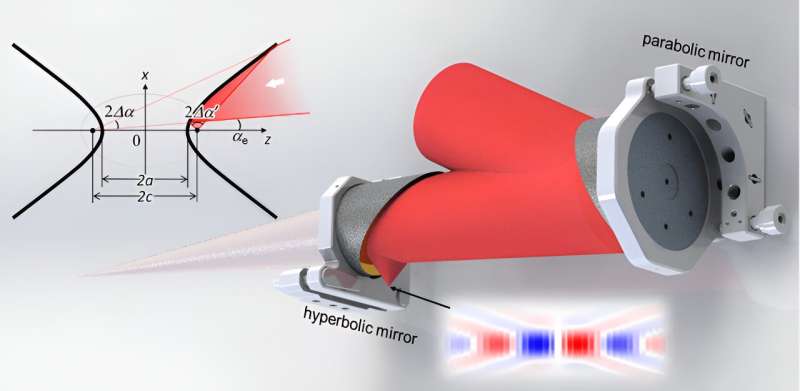This article has been reviewed according to Science X's editorial process and policies. Editors have highlighted the following attributes while ensuring the content's credibility:
fact-checked
trusted source
proofread
Focusing ultra-intense lasers to a single wavelength

Ultra-intense ultrashort lasers are powerful tools used in various fields like physics, national security, industry, and health care. They help researchers delve into strong-field laser physics, laser-driven radiation sources, particle acceleration, and more.
"Peak power" measures the intensity of these lasers, like the Nova laser (Lawrence Livermore National Laboratory, California, U.S.) with 1.5 petawatts of peak power, the Shanghai Super-intense Ultrafast Laser Facility (SULF, China) with 10 petawatts, or the Extreme Light Infrastructure—Nuclear Physics (ELI-NP, Romania) with a peak power of 10 petawatts.
However, what truly matters in experiments is the focused intensity on the target. The lasers are focused onto experimental targets using off-axis parabolic mirrors. The focused intensity, not peak power, reflects the laser's capability and is crucial for users.
Enhancing focus with hyperbolic mirrors
Currently, the beam aperture of these lasers is 150 to 500 mm, and the F-number (related to focusing ability) is 2 to 10. Adding a rotational hyperbolic mirror after the parabolic one can reduce the F-number and thus the focal spot size significantly.
As reported in Advanced Photonics Nexus, this secondary focusing method can reduce the F-number by a factor of 5, which then reduces the focal spot size of the ultra-intense ultrashort laser to a single-wavelength size.
Corresponding author Zhaoyang Li of the Key Laboratory of Ultra-intense Laser Science and Technology, Shanghai Institute of Optics and Fine Mechanics (China), notes that this technique enables the smallest possible focal spot: "Utilizing hyperbolic mirrors for secondary focusing can reduce the focal spot of our ultra-intense ultrashort lasers from a several-wavelength size to just a single-wavelength size, achieving the smallest focal spot possible."
Li and his team report that single-wavelength focal spots can be achieved by adding an optimized rotational hyperbolic mirror to current femtosecond petawatt-class lasers or future single-cycle petawatt-class lasers.
"In combination with our previously proposed Wide-angle Non-collinear Optical Parametric Chirped Pulse Amplification (WNOPCPA) method, it is expected to reach the highest intensity condition of an ultra-intense ultrashort laser facility, that is focusing all laser energy into a spatiotemporal focal cube edged by the laser center wavelength. This will dramatically enhance the experimental capability of ultra-intense ultrashort lasers in the application of strong-field laser physics, such as vacuum quantum electrodynamics," says Li.
More information: Zhaoyang Li et al, Single-wavelength size focusing of ultra-intense ultrashort lasers with rotational hyperbolic mirrors, Advanced Photonics Nexus (2024). DOI: 10.1117/1.APN.3.3.036002
Provided by SPIE





















